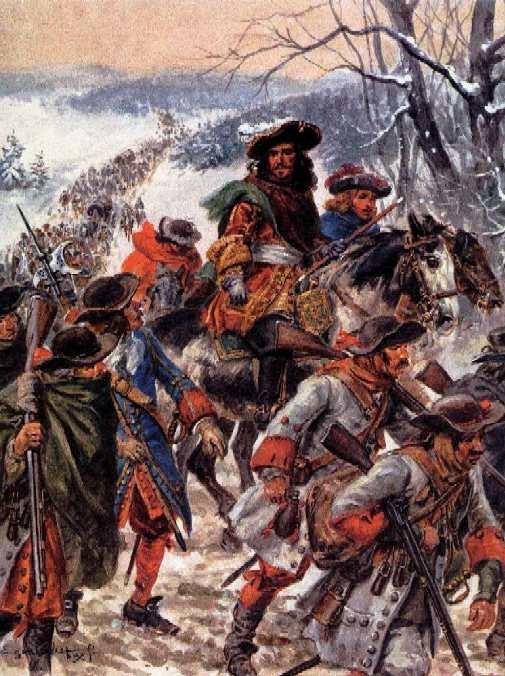Turenne marching with his troops
Turenne was transferred to the Rhineland to fend off German allies of the Dutch, skillfully fighting Brandenburgers and allied German and Imperial princes over the winter of 1672-1673. In a series of clever surprise maneuvers, he crossed Westphalia to desolate Brandenburg, forcing Friedrich-Wilhelm temporarily out of the war.
In his last series of four campaigns, from mid-1674 into early 1675, Turenne displayed a mastery of maneuver based upon a deliberate reliance on mainly cavalry forces. He won a small but influential affair at Sinzheim (June 16, 1674). He then crossed to the right bank of the Rhine in July and proceeded to ravage the Palatinate. He exacted heavy contributions, burned fields and fodder to deny the enemy’s ability to move, and enforced harsh executions of villages that refused to pay. Depredation of the Palatinate by his troops was so extreme it provoked vicious reprisals by local German peasants, or Schnapphahns. Even Louis XIV worried that Turenne’s actions might drive more minor German states into the Allied coalition, though Louvois urged Turenne to still harsher measures. When Strasbourg capitulated to the Imperials, and with 20,000 Brandenburgers threatening to join the Imperial army of 30,000 there, Turenne decided to fight at Enzheim (October 4, 1674), where he won the day. During his fourth campaign of 1674-1675 he won a sharp action against Allied cavalry at Mulhouse (December 29, 1674) and defeated Friedrich-Wilhelm at Türkheim (January 5, 1675).
For the next seven months, Turenne conducted another campaign of maneuver against Montecuccoli. Short on food and fodder, he tried to force battle at Sasbach on July 27, 1675. Before the fight really got under way, an Imperial cannonball crushed his chest, killing him instantly. His loss caused the army to fall back across the Rhine into Alsace. There it was reinforced by the Great Condé, just before that sickly and debilitated, although younger, rival to Turenne more voluntarily retired from military service. Napoleon later recorded Turenne as one of seven “great captains” of military history, and he is today generally regarded as such by most specialist military historians.
Battle of Sinzheim, (June 16, 1674)
Turenne commanded a small force of 6,000 cavalry and 2,000 infantry against an Imperial army of 7,000 cavalry and 2,000 infantry under Count Caprara. The Imperials held ground behind a small stream. While opposing infantry engaged in the town, Turenne personally led his French cavalry in an uphill charge against the Imperial cavalry. The French routed the Imperials from the field, but lost 1,500 casualties to the enemy’s 2,500.
Battle of Enzheim (Ensheim), (October 4, 1674)
A battle fought in the middle of the Dutch War (1672-1678). Strasbourg’s civic leaders capitulated when faced with an Imperial force of 30,000 under Bournonville. Marching to join them was Friedrich-Wilhelm, with 20,000 Brandenburgers. French forces defending Alsace were thus threatened by greatly superior numbers of enemy troops: Turenne had only 25,000 men (including allied English regiments, one led by John Churchill, the future Duke of Marlborough). Turenne decided to attack before his enemies could unite. He force-marched to the Imperial encampment at Enzheim, leaving Bournonville no choice but to accept battle. Turenne deployed his infantry in two lines with some cavalry support, but with most cavalry in a central reserve. Bournonville also placed his infantry in a classic formation of two firing lines, with his left anchored on a large copse. This flank was immediately attacked, and soon uprooted and unhinged by French dragoons infiltrated into the woods. Bournonville countered by advancing his second line and shifting units from his center to his left, and then he sent in his reserve. Turenne followed suit, sending infantry from his center and some of his cavalry reserve into the fight in the woods. Damp weather prevented artillery from playing a significant role in the fight, which played out with muskets and close-order weapons at intimate ranges. The Imperials fell back to prepared field fortifications, which halted any further French advance. As the fight on the flank petered out, Bournonville sent his cavalry to attack the weakened French center. The French infantry formed squares, mostly repulsing repeated Imperial charges. A cavalry-on-cavalry fight ensued, with the Imperial horse finally faltering, then pulling back. That night, the Imperials abandoned their fortifications and encampment, leaving the field to the French. Turenne lost 3,500 men, compared to enemy casualties of about 3,000, but he had won a tactical victory.
Battle of Türkheim, (January 5, 1675). “Colmar.”
After surprising and defeating Allied cavalry at Mulhouse (December 29, 1674), Turenne led 30,000 men in an attack on Friedrich-Wilhelm at Türkheim (Colmar). The Great Elector opposed Turenne with a motley Allied crew of 35,000 men, most of whom were quite unused to fighting together. Turenne fixed the Allies at the center with feints and light attacks, while cleverly using the local terrain to conceal a flanking maneuver by infantry sent around the Allied left. The battle reduced to a fight for control of the town of Türkheim, with each side pouring in reinforcements until the Germans broke and ran. The Allies suffered around 3,000 total casualties and withdrew during the night, leaving their wounded to the French. French losses were lighter, and Turenne held the field.
